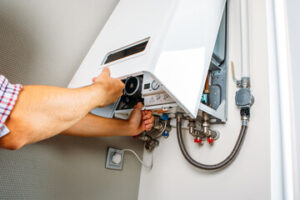Roofing installation is a complicated and dangerous job that requires specialized knowledge of safety protocols and the ability to handle heavy materials at high heights. It’s also a time-consuming process that can be difficult to understand. For professional help, contact Roofing Absecon NJ now!

The first step in roofing is installing the drip edge, which prevents water from running down the fascia boards and causing damage. Then, the underlayment is rolled out and secured to the roof deck.
The cost of roofing installation varies depending on the size and type of roof, as well as additional materials. For example, metal roofs are more expensive than shingle roofs. Also, a steep roof will cost more because it requires safety harnesses and other equipment to work on. The cost of roofing can also vary by location, as some areas have higher labor and material costs.
The biggest expense is labor. Roofing contractors charge hourly rates for their services, which can add up quickly when the job is large. The average hourly rate for a roofing contractor is $26/hour. This makes the total labor cost for a typical shingle roof around $4,600, while a metal roof is closer to $15,200.
Roof replacement is a labor-intensive project that requires attention to detail and knowledge of roofing materials. It’s important to get multiple bids for the job, as prices can vary significantly. To help lower your roofing installation cost, hire a professional roofer with experience working on the type of roof you have. You should also make sure the roofing company is insured and able to pull building permits.
Other factors that influence the cost of roofing are the roof’s materials and any roof penetrations or ventilation. For instance, if you want to add a skylight or plumbing vent, the roofing pro will need to install flashing to seal the area. Flashing is a thin piece of sheet metal installed in areas that are prone to leaks, such as the roof valleys and chimneys.
Another factor that affects the cost of a roof is the amount of insulation. Good insulation helps reduce energy bills and keeps the home more comfortable. It’s important to discuss the insulation options with your roofing contractor before making a decision.
Many roofing companies say the price of a new roof “depends” on the type of roof and materials used. They’re not lying—the cost of a new roof varies widely, from affordable asphalt shingles to luxury copper.
When evaluating roofing installation quotes, be sure to compare the prices of all the components included in the job. For instance, if the roofing contractor lists only the shingles and doesn’t include an itemized list of other products, such as underlayments and ridge caps, that could be a red flag. Mixing and matching different roofing products can void the manufacturer’s warranty.
Materials
Whether you’re planning a DIY roofing project or hiring professionals to work on your home’s roof, you need two things: quality workmanship and the right materials. This roofing materials list can help you determine what tools and supplies you’ll need to get the job done.
Rolled roofing is the mainstay for low-slope residential and outbuilding roofs. It comprises large rolls of asphalt material topped with mineral granules. It is one of the most affordable types of roofing, but it doesn’t offer much in terms of aesthetics.
Membrane roofing is an alternative for flat or low-slope roofs. It can be made from a range of watertight materials like Neoprene, PVC or rubber EPDM. It is highly durable and long-lasting, with a lifespan of up to 35 years. It is also easy to install, with a peel-and-stick cold application.
Wood roofs comprise either shingles or shakes, both of which are typically crafted from cedar or redwood. Shingles have a crisp, clean look because they are sawed to a uniform size and thickness. Shakes, on the other hand, are split by hand into thick wedges and have a more rustic look.
Clay or concrete tiles are an elegant option for homes. They are long-lasting and non-combustible. They add a touch of elegance and are often found on Mediterranean, Mission or Southwestern style homes. They are expensive, however, and can add a lot of weight to the structure of the house.
Installation
Roofing installation is a meticulous process. It requires the skills of a qualified roofing contractor, knowledge of safety protocols, and the ability to work in all weather conditions. A roof protects the occupants of a building from rain, sun, and wind. It must be installed correctly to prevent water from seeping into the structure and causing damage.
The first step in a roofing project is to inspect the existing roof deck. This ensures that the sheathing is sound and capable of supporting a new roof. It also identifies any areas that need repair or replacement.
After a thorough inspection, the roofers will begin to remove the old shingles and underlayment. They will carefully cover any plants or objects on the ground with tarps and use wooden boards to protect things like air conditioning units and gardens. They will then have a dumpster delivered and parked nearby to dispose of the waste.
After the removal, roofers will install a new underlayment and shingle layer. They will start at the eaves and work their way up, overlapping each row to create a waterproof barrier. They will also install flashing around roof penetrations, such as chimneys and vents, and drip edge to direct water away from the roof’s edges.
Maintenance
Roofing installation is a complex task that requires specialized knowledge and skills. It also involves working with heavy materials at high heights. For this reason, it is important to use a qualified contractor who can provide quality workmanship and abide by safety protocols. In addition, proper maintenance procedures can help prevent costly repairs and extend the life of your roof.
A thorough inspection should be conducted after the new roof is installed. The inspector should look for shingles that are cracked, loose or missing. If any shingles are damaged, they should be replaced immediately to avoid water damage to the interior of your home. He or she will also check for flashing. These are strips of metal that cover areas around penetrations such as chimneys, vents, and skylights. They are designed to divert water from vulnerable areas of the roof and protect against leaks. If the flashing is cracked, loose, or rusted, it should be repaired as soon as possible.
Other important maintenance tasks include ensuring that drains and gutters are clear of debris and are not blocked by clogged downspouts. It is also important to trim trees so they don’t overhang the roof. This will keep debris from accumulating on the roof, which can cause wood rot and leaks. It is also a good idea to clean the drains and gutters before stormy weather arrives.
When performing routine maintenance, it is a good idea to remove any twigs, branches, and leaves that may have fallen on the roof. These items can clog the drainage system and cause water to back up into the house. In addition, it is a good idea to clear out any debris that has collected in the valleys and ridge vents. Inspecting the roof’s penetrations is another important maintenance task. It is essential to ensure that the seals around chimneys, vents and other features are in good condition.
A roof is an integral part of a building, and it provides aesthetic value, all-round protection, and functional benefits. However, the majority of homeowners ignore its maintenance procedures until it is too late. Consequently, they suffer from costly repairs and a diminished property value.

